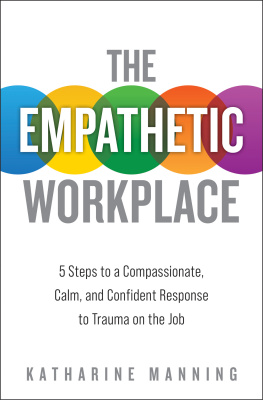Katharine Manning - The Empathetic Workplace
Here you can read online Katharine Manning - The Empathetic Workplace full text of the book (entire story) in english for free. Download pdf and epub, get meaning, cover and reviews about this ebook. year: 2020, publisher: Harpercollins Leadership, genre: Religion. Description of the work, (preface) as well as reviews are available. Best literature library LitArk.com created for fans of good reading and offers a wide selection of genres:
Romance novel
Science fiction
Adventure
Detective
Science
History
Home and family
Prose
Art
Politics
Computer
Non-fiction
Religion
Business
Children
Humor
Choose a favorite category and find really read worthwhile books. Enjoy immersion in the world of imagination, feel the emotions of the characters or learn something new for yourself, make an fascinating discovery.
- Book:The Empathetic Workplace
- Author:
- Publisher:Harpercollins Leadership
- Genre:
- Year:2020
- Rating:3 / 5
- Favourites:Add to favourites
- Your mark:
- 60
- 1
- 2
- 3
- 4
- 5
The Empathetic Workplace: summary, description and annotation
We offer to read an annotation, description, summary or preface (depends on what the author of the book "The Empathetic Workplace" wrote himself). If you haven't found the necessary information about the book — write in the comments, we will try to find it.
The Empathetic Workplace — read online for free the complete book (whole text) full work
Below is the text of the book, divided by pages. System saving the place of the last page read, allows you to conveniently read the book "The Empathetic Workplace" online for free, without having to search again every time where you left off. Put a bookmark, and you can go to the page where you finished reading at any time.
Font size:
Interval:
Bookmark:

For my family.
Everything I am and everything I have
is because of you.
2021 Katharine Manning
All rights reserved. No portion of this book may be reproduced, stored in a retrieval system, or transmitted in any form or by any meanselectronic, mechanical, photocopy, recording, scanning, or otherexcept for brief quotations in critical reviews or articles, without the prior written permission of the publisher.
Published by HarperCollins Leadership, an imprint of HarperCollins Focus LLC.
Any internet addresses, phone numbers, or company or product information printed in this book are offered as a resource and are not intended in any way to be or to imply an endorsement by HarperCollins Leadership, nor does HarperCollins Leadership vouch for the existence, content, or services of these sites, phone numbers, companies, or products beyond the life of this book.
ISBN 978-1-4002-2003-8 (eBook)
ISBN 978-1-4002-2002-1 (PBK)
Epub Edition December 2020 9781400220038
Library of Congress Control Number: 2020949808
Printed in the United States of America
20 21 22 23 LSC 10 9 8 7 6 5 4 3 2 1
Information about External Hyperlinks in this ebook
Please note that the endnotes in this ebook may contain hyperlinks to external websites as part of bibliographic citations. These hyperlinks have not been activated by the publisher, who cannot verify the accuracy of these links beyond the date of publication
Could a greater miracle take place than for us to look through each others eye for an instant?
HENRY DAVID THOREAU
L ife is messy. We strive for order. We set our goals and tick off our action items. We weigh our options and try to make good decisions. Nonetheless, the unexpected intervenes. We are knocked off track by challenges from the small to the life-changing: illness, accidents, bias, harassment, violence, financial woes, and more.
As much as we seek to avoid it, we carry these struggles with us. They affect us in our homes, in our communities, and they affect us at work. How leaders respond to the traumas that inevitably show up in their workplaces can determine the success or failure of the organization as a whole. An empathetic response instills trust, which in turn increases productivity, reduces absenteeism and turnover, and enhances engagement and satisfaction. Just as importantly, compassion makes it more likely that those in need will get help. It also bears noting that empathy lapses have shown up in more headlines and lawsuits than many would care to recount. This book teaches the skills to respond with calm and confidence to traumas at work, whenever and wherever they arise.
BENTON SAT AT the head of the table, with twenty sets of eyes fixed on him. Arrayed around him were the mayor, the chief of police, the superintendent of schools, and other city leaders, each of whom had a deputy, who sometimes had a deputy.
Benton had been called to this room because of a tragedy. The city, like too many others before and after it, had experienced a school shooting. Now, headlines blared, news crews jostled for position in their formerly quiet town, and the streets were flooded with donations of flowers, toys, and cards from well-wishers. The nation grieved with them. But the citys leaders were paralyzed.
They needed a plan for ongoing support of the victims families. They needed to decide whenor even whetherto reopen the school. They needed to answer the angry inquiries and threats of lawsuits about school security. And they needed to find a place for all of those donations.
The problem wasnt a lack of support. The federal government had offered them a near-blank check, as well as all the technical assistance and guidance they could need. The problem was that they couldnt act. Devastated by what had happened and overwhelmed by the hordes of outside press, donations, and aid, they had grown wary of offers of help and had developed the mind-set of a town under siege. Meanwhile, the school remained closed, no path for ongoing counseling had been established, and flowers wilted in the streets.
That was why Benton was here. Experienced in city crises from urban riots to a raid on a fundamentalist cult, Benton had been asked to come to this town to see if he could help break the impasse so that outside services could be brought in. Benton knew that logic, charts, plans of action, or statistics would not help.
Instead, he asked questions.
He asked about what had happened, and what had happened next, and what had happened after that. He asked about their roles, their thoughts, their regrets.
And as he asked, the tears began to flow. These civic leaders, in their gray suits with their padfolios, sat around that giant oak table and they wept. Benton, who had sat with mothers who had lost both sons to gang violence, with those who had been beaten and sexually assaulted, had never before seen so many tears in one room.
What those tears broke through was not an administrative logjam. It was the anguish at losing those beautiful children. It was the frustration at their own powerlessness. It was the devastating knowledge that this had happened on their watch. And because it broke through those, the administrative challenges were surmountable.
When the tears subsided, the mayor looked at Benton. Clearly, he said, we should have brought you in a long time ago.
IVE BEEN WORKING with victims for more than twenty-five years as a counselor, advocate, and legal advisor. For fifteen years, I served as a senior attorney advisor with the Executive Office for United States Attorneys, advising the Justice Department on its most challenging victim issues in cases ranging from terrorism to large-scale financial fraud to child exploitation. Some of the cases I advised on include the Boston Marathon bombing, the Pulse nightclub and South Carolina church shootings, Charlottesville, Enron, Madoff, 9/11, and the federal case against Larry Nassar, doctor for the US Womens Olympic Gymnastics team. I have trained thousands of individuals on compliance with their responsibilities to victims, and I teach a course on victim rights at American University.
Through all of this work with diverse types of trauma, I began to realize something: all trauma is fundamentally the same. The degree varies, of course, and each persons experience is unique. The skills I would use to assist a victim of domestic violence on a hotline call, though, are the same ones I would use to comfort a colleague who bursts into tears in my office when one more assignment becomes one assignment too many or one who paces in front of my desk in anger at being belittled in a meeting. When the crisis comesand all of us are going to face the crisis eventuallywe need the same things.
Unfortunately, a lot of us struggle to give those things. We feel that we should have something more or different to give. We want to fix the problem. We feel uncomfortable, for reasons that may be beyond our control (empathy can wreak havoc sometimes). Its messy and we dont want to get involved. Of course, by pushing these issues away, we only exacerbate them. They simmer below the surface, and eventually boil over. These issues are more prevalent than you might think.
T rauma is not a jacket that we can shed when we walk through the office door. We carry it with us. It affects our relationships, our physical and mental health, and it affects us at work. From sexual harassment and domestic violence to addiction and financial distress, the issues we face outside work come with us to work.
Font size:
Interval:
Bookmark:
Similar books «The Empathetic Workplace»
Look at similar books to The Empathetic Workplace. We have selected literature similar in name and meaning in the hope of providing readers with more options to find new, interesting, not yet read works.
Discussion, reviews of the book The Empathetic Workplace and just readers' own opinions. Leave your comments, write what you think about the work, its meaning or the main characters. Specify what exactly you liked and what you didn't like, and why you think so.












